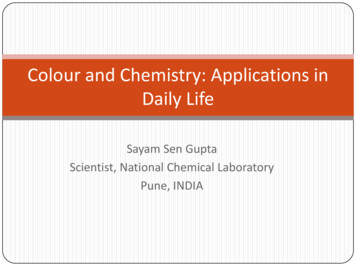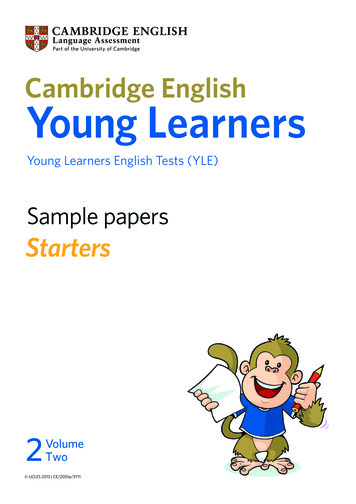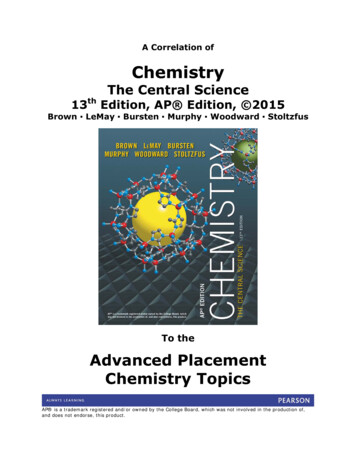
Transcription
Colour and Chemistry: Applications inDaily LifeSayam Sen GuptaScientist, National Chemical LaboratoryPune, INDIA
Chemical IndicatorsAny substance that gives a visible sign, usually by acolour change, of the presence or absence of athreshold concentration of a chemical species.Example: Acid-Base Indicators PhenolpthaleinWater to WineAcidic: ColorlessBasic: Pink
Acid, Base and pH in a nutshellBasesAcidspH is a measure of the concentration of H ions in a solutionpH0Acid7Neutral14Base
Color and Molecular Structure Light delivers energy in little packets called photons Different colors of light pack different amounts of energy intheir photons All materials absorb photons of some energy. But onlysubstances that absorb photons of visible light will have color Different molecules absorb different colors of light,depending on their electronic structure
Mystery behind “Water to Wine”In BaseMolecule flat: electronmoves freely overmost of molecularframeworkIn AcidMolecule not flat:electron does notmove freely andabsorbs in the UV
Red Cabbage: Natural IndicatorRed CabbageNatural pH sensitive indicator2.13.65.97.07.49.8 n
Mood LipsticksProduct Description: Colour changes instantlyaccording to body chemistry - Long lasting 12 hour lipcolour - Moisturizes and protects with ALOE VERA andantioxidants Vitamins A, C & E
Methylene Blue: Redox IndicatorLeucomethylene BlueMethylene BlueReductionOxidationBlueColorlessSolution contain Glucose, Methylene Blue and Sodium HydroxideReaction 1Methylene Blue GlucoseReaction 2Leucomethylene Blue O2Leucomethylene Blue Sodium GluconateMethylene Blue H2O
Methylene Blue as Oxygen Indicator Presence of oxygen necessary for re-oxidation If vial is not opened after each experiment to let insufficient oxygen, the re-oxidation to methylene bluedoesnot work Can be used to determine the presence of oxygen incertain samples
Methylene Blue as indicator for testingmilk qualityMilkPasteurized (does not containmicroorganisms)Unpasteurized (contain bacteriasuch as lactobacillus sp)Pasteurized Milk Methylene BlueUnpasteurized Milk Methylene BlueRemains BlueSlowly turnscolorless
Indicators here, there, everywhere
Indicators to Detect Blood in Crime SceneHaemoglobin H2O2Reduced Phenolpthalein:Colorless½ O2Oxidized Phenolpthalein inBase: Pink
The Composition of PaintPaint is composed of colored pigment and a binderPigment: Colored powdered substance (minerals,inorganic salts, dyes)Binder: Material that evenly disperses the pigment,adheres to surface when paint applied and then driesAdditives: Such as Glycerine for brushability,antioxidants to prevent paint spoliagePaints are homogeneous mixtures, areuniform throughout
Brief but Colorful History of PaintBison Dated 35,000 years ago Painted in cave walls bythe Cro-Magnon man , ourPaleolithic ancestors Found in Lascaux, FrancePigmentBinderSaliva and animal fat
Earth’s Natural PaletteRedHematite: Iron OxideCinnabar: Contains mercury; toxicBlueLazurite: Bright blue; veryexpensiveAzurite: Blue with green tinge;basic copper carbonate muchcheaper; used by Michelangelo
Earth’s Natural PaletteYellow and OrangeOrpiment and Realgar: usedas late till 19th century whenit was discovered to havearsenic.Van Gogh’s mental illnessand Monet’s blindness wereprobably caused by itGreenMalachite is a coppercompound and is possibly theoldest known green pigmentused.
Inorganic Salts as PigmentsColored Pigments can be formed by precipitationof aqueous ions in solutionYellow lead chromatePb(NO3)2 Na2CrO4PbCrO4 2NaNO3White zinc hydroxideZn(NO3)2 NaOHZn(OH)2 2NaNO3Blue Copper CarbonateCu(NO3)2 Na2CO3CuCO3 2NaNO3
The FrescosMichelangelo: Created the mostinfluential works in Fresco in thewestern art historyCeiling of Sistine Chapel,Vatican CityCreation of Adam
Painting of Fresco’s and Secco’s: EggTempera They were done mostly using egg tempera paint It contains a colored pigment and the yolk of an eggmixed with water The egg temperas were absorbed into freshlyspread wet plaster and remained vibrant as long asthe paint survived The paint became part of the plaster
Making Binder for Egg TemperaThe egg yolk will now be mixed with equalamount of water to make the binder
The pigmentYellow lead chromatePb(NO3)2 Na2CrO4PbCrO4 2NaNO3White zinc hydroxideZn(NO3)2 NaOHZn(OH)2 2NaNO3Blue Copper CarbonateCu(NO3)2 Na2CO3CuCO3 2NaNO3
Oil PaintingsOil Paints, pigment combined with oil discoveredin early 15th century. Oil such as terpentine oiland linseed oil is the binder.Sunrise- An impression by MonetStarry Nights by Van Gogh
Acrylic paints and other mediumPoster PaintTransparent Water Color
Art Restoration Great works of art are susceptible to effects of aging,temperature and humidity changes, and exposure to lightneeds to be conserved Conservation involved cleaning the work, analyzing thework for damage, restoring the damaged areas andpreserving the original Understanding the usage of pigments and binders overages is utmost important to carry out proper restoration
Fun Activity for youCreate a pallet of natural paints. How?Find colored rocks. Grind each rock with amortar and pestle. Add a binder to thepowdered rock. Binders can be egg yolk, starchor even glue. Now you have paints. Use thesepaints in a drawing. Try to identify an element ora combination of elements that produce certaincolors
AcknowledgementMr. Mrityunjoy KarMr. Chakadola PandaReference- Chemical Curiosities: SpectacularExperiments and Inspired Quotes by H. W. Roesky
Oil Paintings. Oil Paints, pigment combined with oil discovered in early 15. th. century. Oil such as terpentine oil and linseed oil is the binder. Sunrise- An impression by Monet. Starry Nights by Van Gogh. Acrylic paints and other medium. Poster Paint. Transparent Water Color. Art Restoration











